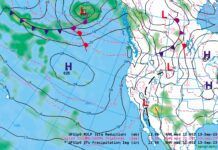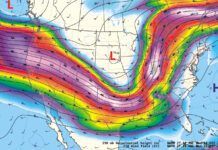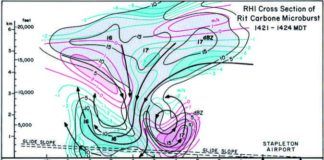– 10 m wind corresponds exactly to the wind as would be observed. The model data also offers gust strength and maximum wind for the hour.
– 1 km AGL reflectivity is equivalent to airborne radar at 1 km or a normal single-site radar image you might find on the Internet.
– Composite reflectivity provides a composite of radar data at all elevations above a given point and is often seen in regional radar mosaics found on the Internet. Provides a sort of “worst case” picture.
– 925, 850, 700, etc. temp show temperatures at given pressure altitudes and give you a forecast of wind.
– Aviation flight rules categorizes conditions into LIFR, IFR, MVFR, and VFR based on the visibility, ceilings, and low cloud-cover products.
– Visibility gives an approximate measure of fog or haze density.
– Cloud top height when low, suggests you will have no problems getting above the overcast. Cloud top heights above 30,000 feet can be either cirrus or thunderstorm anvils.
– Low cloud cover indicates the percentage of cloud cover below 6500 feet AGL. In combination with the ceilings product, this can help assess the possibility of IMC. Cloud cover amounts are strongly tied to the relative humidity and upward motion that exists in that atmospheric layer.
– Mixed CAPE is directly correlated with vertical velocity in storms. With CAPE values below 500, storms contain weak circulations. Above 1000, circulations will be very strong. Anything above 2000 should be considered lethal.
-CCL is the convective condensation level and indicates the height of any cumulus bases in meters.
– PBL height often corresponds to the top of the haze layer. Unless a jet stream is above this level, smoother flying conditions are often found above the PBL.




